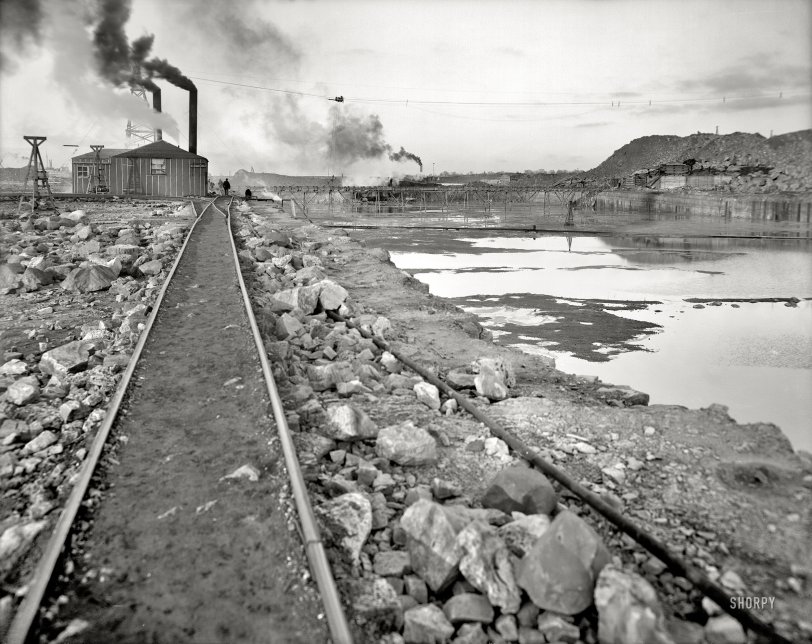


Framed or unframed, desk size to sofa size, printed by us in Arizona and Alabama since 2007. Explore now.
Shorpy is funded by you. Patreon contributors get an ad-free experience.
Learn more.

- Baldwin 62303
- Baldwin VO-1000
- Cold
- No expense spared
- Tough Guys
- Lost in Toyland
- And without gloves
- If I were a blindfolded time traveler
- Smoke Consumer Also Cooks
- Oh that stove!
- Possibly still there?
- What?!?
- $100 Reward
- Freeze Frame
- Texas Flyer wanted
- Just a Year Too Soon
- WWII -- Replacing men with women at the railroad crossing.
- Yes, Icing
- You kids drive me nuts!
- NOT An Easy Job
- I wonder
- Just add window boxes
- Icing Platform?
- Indiana Harbor Belt abides
- Freezing haze
- Corrections (for those who care)
- C&NW at Nelson
- Fallen Flags
- A dangerous job made worse
- Water Stop
Print Emporium
Livingstone Channel: 1910

"Livingstone Channel, looking east." Construction of the navigation channel along the Detroit River circa 1910. 8x10 dry plate glass negative. View full size.
Detroit River Bypass
The $10M appropriated for this much needed "Ditch" was only a scratch on the surface. This feat of engineering was to cost many more millions before it was completed to the satisfaction of the shipping industry in the 1930's. The channel itself was cut in the "dry," meaning the river was dammed in the area of excavation and pumped out. It was completed in sections. The photo shown is looking northward, I believe, and one can see the power houses used for supplying electricity to the huge travelling bucket towers in the background. The pile of rock to the right in the photo was left there and today it is referred to as Spider Mountain by the locals. The specifications for the initial cut was: 12 miles long 22 feet deep and 300 feet wide (min.) On completion in 1912 it was already outgrown by the increase in size of the newer vessels and plans were set underway for enlarging the system even more.
Mr. Livingstone's progeny and legacy
William Livingstone has previously appeared with his children here in the "Classic Rockers: 1900" photo. According to this source, he served as president of the Lake Carriers Association from 1909 until his death in July, 1925.
The channel which was named in his honor is located here in the lower Detroit River on the west side of Bois Blanc (Bob-Lo) Island. It is used by downbound vessels while upbound vessels use the Amherstburg Channel east of the Island, except during the slow winter shipping season when the Livingstone Channel is used in both directions as a traffic-controlled, one way channel.
$10 Million Ditch
New York Times, Oct 20, 1912New Channel at Detroit
Navigation into Lake Erie Made Easier — The Opening Celebrated.
Detroit, Mich., Oct. 19. — With the booming of guns and blowing of steamship whistles, the Livingston channel, from the lower Detroit River into Lake Erie, was formally opened to commerce to-day and a fleet of fifteen vessels passed through it and on to lower lake port destinations.
The new channel is constructed at a cost of $10,000,000 and will relieve congestion in the dangerous Lime Kiln crossing, where rocky banks and a swift current have heretofore troubled navigators and deleayed traffic. The ceremonies to-day were under the auspices of the Lake Carrier's Association.
The City of Detroit, Michigan, Vol. IV, 1922.For a number of years Mr. [William] Livingstone advocated the construction of an independent waterway for down-bound vessels in the lower Detroit river and spent much time interesting the government engineers in the work and prevailing upon congress to supply the necessary funds for the development of the channel. In 1906 congress made an appropriation for surveys and in 1907 appropriated funds for the work and authorized it to be known as the "Livingstone Channel" in recognition of the many services rendered by Mr. Livingstone. Work was begun in the spring of 1908 and completed in the fall of 1912. The channel was opened to commerce October 19, 1912, with imposing ceremonies. This channel ranks with the important engineering feats of the age.
























On Shorpy:
Today’s Top 5